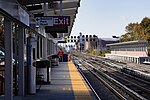Belmont Park station

Belmont Park is a seasonal-use Long Island Rail Road station on the grounds of the Belmont Park racetrack in the New York City borough of Queens. The station is a terminus of a spur line that lies south of and between the Queens Village and Bellerose stations on the Main Line/Hempstead Branch. Consistent with the names of other lines and branches of the LIRR, the spur line is called the Belmont Park Branch. Train service to the Belmont Park station is operated only for special events such as the Belmont Stakes. Starting in November 2021, the venue has also been served full-time by the Elmont station, located directly to the north and along the Main Line/Hempstead Branch. Unlike the rest of the property on Belmont Park, the Belmont Park station is part of a small sliver of Belmont property (including some parking) that is located in Queens. The racing complex is located in Nassau County.
Excerpt from the Wikipedia article Belmont Park station (License: CC BY-SA 3.0, Authors, Images).Belmont Park station
Cross Island Parkway, New York Queens County
Geographical coordinates (GPS) Address External links Nearby Places Show on map
Geographical coordinates (GPS)
| Latitude | Longitude |
|---|---|
| N 40.713655 ° | E -73.728299 ° |
Address
Belmont Park
Cross Island Parkway
11429 New York, Queens County
New York, United States
Open on Google Maps









